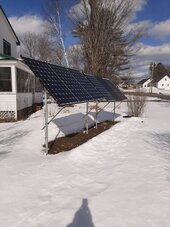hightecrebel
New Member
- Joined
- Dec 26, 2021
- Messages
- 11
Anyone on here from a "north-eastern" coastal area (Maine, New Hampshire, Nova Scotia, Newfoundland, etc.)? I'm trying to plan out my system here in mid-coast Maine, but in the various resources I've been using I've found little to no accounting for "coastal effect" weather patterns in the winter, so I was hoping to pick your brains about your experiences. Mainly the following:
1. How big of a drop do you experience in generation, summer vs winter?
2. How big of an issue is freezing rain/sleet with the panels compared to snow, and how do you deal with it?
3. Any issues cropping up from the salt in the air fast-tracking corrosion?
4. Any special considerations for systems prior to a Nor'easter?
5. Any odd/unexpected issues I should be aware of that will crop up later?
1. How big of a drop do you experience in generation, summer vs winter?
2. How big of an issue is freezing rain/sleet with the panels compared to snow, and how do you deal with it?
3. Any issues cropping up from the salt in the air fast-tracking corrosion?
4. Any special considerations for systems prior to a Nor'easter?
5. Any odd/unexpected issues I should be aware of that will crop up later?




